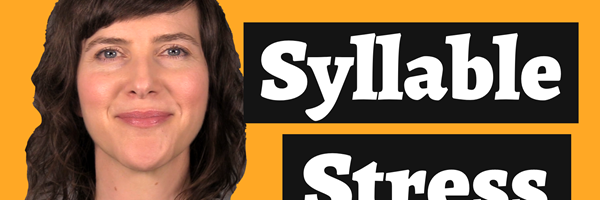(Video Transcript)
Hi, I’m Julie with San Diego Voice and Accent. And in this video, you’ll learn about vowel syncope.
Vowel syncope in American English
Vowel sync -uh - what? I know - the word syncope is a little unusual! But here’s what it means. Vowel syncope is when a sound or syllable is deleted from the middle of a word. The spelling will show that there should be another sound there - but that sound does not occur in the pronunciation.
If you’ve been studying English for a while, you probably know by now that American English likes to change the vowels in a word, especially the unstressed vowels in a word. Unstressed vowels are usually reduced to a sound that is faster to say. In the case of vowel syncope, the unstressed vowel is deleted completely.
I’ve already discussed a few common words in American English that have vowel syncope in their pronunciations. For example, the words aspirin, average, comfortable, and vegetables all have syllables that aren’t typically pronounced. I won’t review the pronunciation of these words since I’ve done it already in prior videos, so if you want more help pronouncing these words, I recommend you watch the earlier videos in the series called Difficult Words to Pronounce in English.
In this video, I want to show you more American English words that have vowel syncope in their pronunciation. And, here’s the annoying thing about vowel syncope. Sometimes you must follow the vowel syncope pronunciation - everyone deletes that syllable, so you need to as well. And other times...well...it can go either way. I’ll point out when the pronunciation is a must, and when it’s maybe not required but it’s the way that most native speakers pronounce the word.
How to pronounce chocolate
I’ll start with a common word: chocolate. This one probably isn’t a surprise for many of you. But if you look at the spelling of this word, it looks like there should be three syllables: "chock - uh - lit".
But there isn’t - the middle vowel has been dropped, and it’s just two syllables: "chock - lit".
This one is a requirement - I’ve never heard anyone pronounce this word as "chok - uh - lit", so you should pronounce it as 2 syllables.
Here is the word chocolate up close and in slow motion.
The lips push away from the teeth for the CH sound. Then the jaw drops for the AH vowel, and the back of the tongue comes up for the K sound. The tongue tip comes up for the Light L, then drops for the IH vowel, then the tip comes up to the alveolar ridge for the final T sound.
How to pronounce favorite
Next is another common word: favorite. Let’s do a little more research on this word. Let’s first look at the IPA transcription on the Cambridge dictionary website.
The first few transcriptions show three syllables:"fave - er - it". And you have to scroll to the very bottom to see the two syllable transcription, "fave-rit". So both are shown on this website.
Now let’s look at forvo.com - how do native speakers pronounce it on that website? Out of 5 recordings, three said it as two syllables: "fave-rit", and two said it as three syllables: "fav-er-it".
Hmm. Now I’m even more confused - which one is it?
There’s one more website we’ll go to - Youglish.com. Let’s hear how native speakers use this word within the context of a conversation. Of the first 10 speakers, they all said favorite as two syllables: "fave - rit".
I agree - I think favorite as two syllables is the more common pronunciation, especially when you use this word in a sentence or conversation. It’s not a requirement, but most people will pronounce it as "fave-rit".
Here is the word favorite in slow motion.
The bottom lip comes up to touch the upper teeth for the F sound. Then the jaw opens for the AY diphthong, and the bottom lip comes up to the upper teeth again for the V sound. Then you move right into the last syllable, which begins with the R consonant. The lips round for the R, and the tongue pulls back. Then you move into the IH vowel, and end on a T sound.
How to pronounce interested
Next is another common word: interested. This word actually has two types of pronunciation changes that can happen. First, we’ll look at the syllable structure. If you look at the spelling, it looks like there should be 4 syllables in this word:
"in - ter - es - ted"
"in - ter - es - ted"
But, the more common pronunciation is "in-tres-tid", as three syllables.
"in - tri - stid"
This isn’t a requirement - sometimes native speakers will pronounce this word as 4 syllables, as in: I’m "in-ter-est-ed" in learning more about that!
But I think it’s much more common to say "in-tres-tid", in three syllables. I'm interested in learning more about that!
Here is the second pronunciation change that can occur with this word. Sometimes when the letters N and T are next to each other, and the T begins a weak syllable, like in interested, native speakers might drop the T sound completely and say,
"innerested"
"innerested". The first T is gone.
"innerested"
But what happened to the syllable count when I used that pronunciation?
"innerested"
The syllables went up to 4!
Again, the more common pronunciation is interested as 3 syllables, and that first T sound is pronounced. But I wanted to share the other pronunciations with you in case you hear them in your studies.
Let’s see the word interested up close and in slow motion.
The first sound is the IH vowel, which is a lax vowel, so the lips are relaxed and neutral. The tongue tip comes up for the N sound while the lips round for the TR cluster. Then the lips relax again for the IH vowel, the tongue tip comes up for the ST cluster. Then the lips relax one more time for the IH vowel, and the tongue tip comes up to the alveolar ridge for the D consonant.
How to pronounce difference
The next word is difference. I just pronounced this word as two syllables.
"diff - rinse"
But the spelling makes it seem like there should be another syllable in the middle -
"diff -er - ense"
"diff - er - ense"
Cambridge dictionary transcribes difference as having three syllables in its first transcription, and later on it shows it has two syllables. Confusing!
Let’s quickly go to Youglish.com to see how native speakers pronounce this word in a conversation. Of the first 10 speakers, all of them pronounce it as two syllables: "diff - rinse". And I agree - this is the more common pronunciation.
"diff-rinse"
It’s not a requirement - you may on occasion hear a native speaker pronounce this word as 3 syllables, "diff-er-ence", but the much more common pronunciation is "diff-rinse" - 2 syllables.
The tongue tip is up at the alveolar ridge for the initial D consonant, then the tongue moves down for the IH vowel, and the top teeth touch the bottom lip for the F consonant. The lips round as you move directly to the R consonant, then the lips relax for the IH vowel. The tongue tip comes up for the N consonant, and moves directly into the final S sound.
How to pronounce separate
The final word we’ll discuss today is the word separate. This word can be both an adjective and a verb. I’ll use it in a sentence.
Here’s the adjective: The manager lives in a separate building. I pronounced the adjective as two syllables: "sep-rit".
Here’s the verb: You need to separate them into two groups. I pronounced the verb as three syllables: "sep-er-ate".
Let’s focus on the adjective pronunciation, since that is the one that can have vowel syncope.
Let’s first look at the Cambridge dictionary website. It shows separate as three syllables in its transcriptions of the adjective form, then at the very bottom it shows it as two syllables, but with a small schwa sound between them. That’s confusing!
So let’s listen on Youglish.com - how do native speakers pronounce this word in a conversation? "Sep-rit" or "sep-er-it"?
Of the first 10 speakers who used separate as an adjective, they all pronounced it as two syllables, "sep-rit".
And I would say this one is a requirement - you should pronounce the adjective form of separate as two syllables, and the verb form of separate as three syllables.
This word begins with the S consonant, then the jaw opens for the EH vowel. The lips close for the P sound, then round for the R consonant. The lips relax for the IH vowel, then the tongue tip comes up to the alveolar ridge for the final T sound.
I hope this video helped you to learn more about vowel syncope in American English! Thanks for watching! And I'd love to hear from you - contact me to learn how we can work together to perfect your American English pronunciation!



